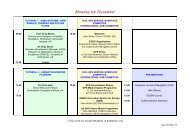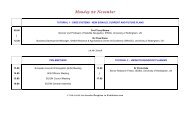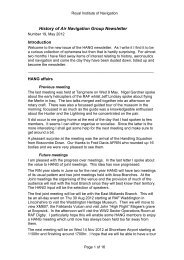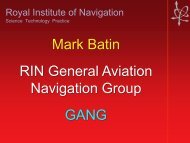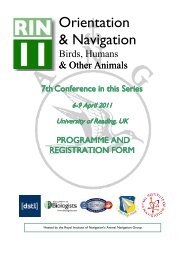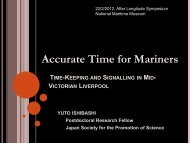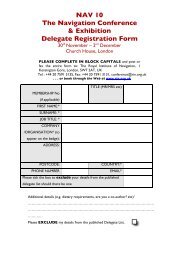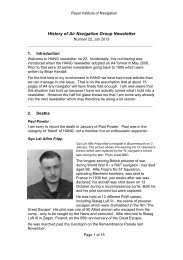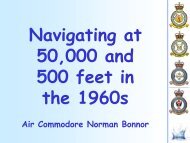Fairway 30 - Royal Institute of Navigation
Fairway 30 - Royal Institute of Navigation
Fairway 30 - Royal Institute of Navigation
Create successful ePaper yourself
Turn your PDF publications into a flip-book with our unique Google optimized e-Paper software.
producing a position in error by up to 22 kilometres. What has continued to work during<br />
this jamming was eLoran.<br />
Enhanced Loran is an internationally standardized positioning, navigation and timing<br />
service. It meets the accuracy, availability, integrity and continuity performance<br />
requirements for aviation non-precision instrument approaches, maritime harbour<br />
entrance and approach, land vehicle navigation and location based services. It is also a<br />
precise source <strong>of</strong> time and frequency for, say, telecommunications. Being independent <strong>of</strong><br />
and dissimilar to GNSS eLoran becomes a complement to satellite systems, enabling<br />
users to retain the benefits <strong>of</strong> GMDSS whilst having a check on its integrity and a back<br />
up during disruption <strong>of</strong> satellite services. eLoran is high powered (250 kW), low<br />
frequency (0.1 MHz) and ground based. This alone makes it very difficult to jam or to<br />
spo<strong>of</strong>. Pseudo-ranges can be interoperated with GPS making it useable indoors, useful in<br />
search and rescue and in large warehouses. It is also able to broadcast Co-ordinated<br />
Universal Time and differential Loran corrections.<br />
The UK’s eLoran station is based at Anthom, in Cumbria, and from a map shown by<br />
Sally, works in conjunction with stations in the Faroes, Norway, Germany and France. It<br />
was moved from Rugby during 2007 and is housed in four steel transport containers<br />
welded together, the antenna being mounted on top and the system runs unmanned. This<br />
is very different from the USA’s Loran C stations, now being closed, which are based in<br />
large buildings and are heavily manned. Before the end <strong>of</strong> 2007 signals had been tested<br />
and verified, with a service being operated at the beginning <strong>of</strong> the following year.<br />
What <strong>of</strong> the future? Even though Loran C is closing down, there are those in the USA<br />
who believe that something like eLoran is essential, and the caesium clocks from Loran<br />
C are being removed for maintenance and storage. Norway, Russia, China and Japan are<br />
looking to eCHAIKA, a similar system. Current research in the UK is carried out in<br />
consultation with the International Lighthouse Authority and the development <strong>of</strong> eLoran<br />
is 50% funded by a grant from the Department <strong>of</strong> Transport. Sally Basker’s estimate is<br />
that coverage <strong>of</strong> the whole <strong>of</strong> Europe with eLoran would cost about the same as that <strong>of</strong><br />
building and launching one Galileo satellite.<br />
Satellite Weather Reception<br />
A short description <strong>of</strong> what is available to the amateur.<br />
If, like me, you are fascinated by the ever-changing weather – not just in the UK, but<br />
worldwide – then you are already aware that a major source <strong>of</strong> weather data comes from<br />
satellites orbiting the earth. Currently, weather information is transmitted from two<br />
entirely different ‘types’ <strong>of</strong> satellite i.e. the LEO (Low Earth Orbit) NOAA National<br />
Oceanographic and Atmospheric Administration) satellites which are in sun-synchronous<br />
orbit around the poles. At the time <strong>of</strong> writing, there are four such satellites, traveling at<br />
approximately 32,000 kph at a height <strong>of</strong> some 840 kilometres. This means that each<br />
orbit takes approximately 100 minutes and, because <strong>of</strong> the earth’s rotation, the swathe <strong>of</strong><br />
32




